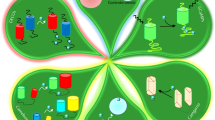Abstract.
This review covers both methodical aspects and actual applications of ion imaging techniques in plant cell signal research. The methodological section explains the basic principles of fluorescence ion imaging, the impact of modern developments in fluorescence microscopy and introduces the most important fluorescence probes including aequorin and other photoproteins. It critically comments on loading strategies, intracellular compartmentation of probes and calibration procedures. The second part compiles actual research areas where the application of ion imaging procedures has gained substantial achievements and helped to establish new concepts of calcium- and pH-dependent signalling. Examples comprise the hormonal control of stomatal movements, effects of gibberellic and abscisic acids in aleurone cells, elicitation of phytoalexin production, cytosolic pH and cell development, and signatures of Ca2+ as a universal signal in plant cells.
Similar content being viewed by others
Author information
Authors and Affiliations
Additional information
Received: 26 May 1999 / Accepted: 2 August 1999
Rights and permissions
About this article
Cite this article
Roos, W. Ion mapping in plant cells – methods and applications in signal transduction research. Planta 210, 347–370 (2000). https://doi.org/10.1007/PL00008144
Issue Date:
DOI: https://doi.org/10.1007/PL00008144




